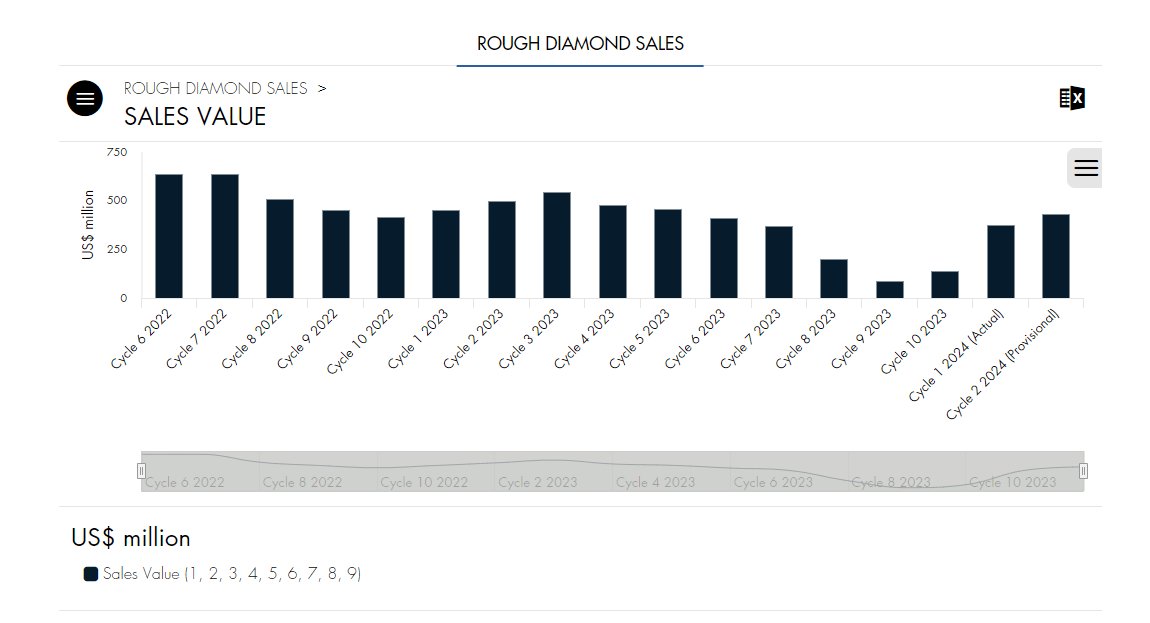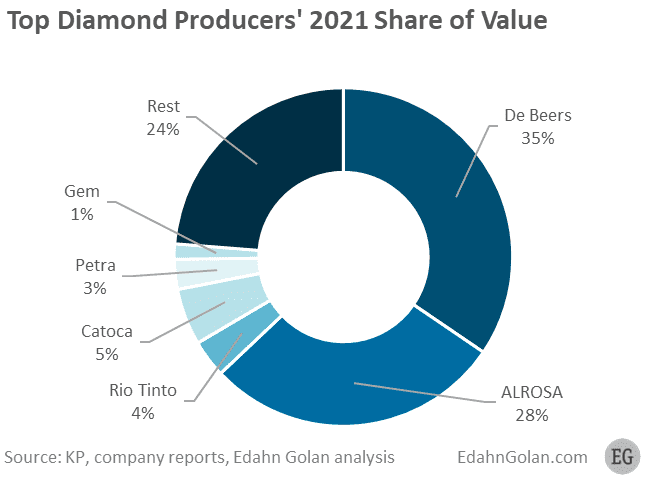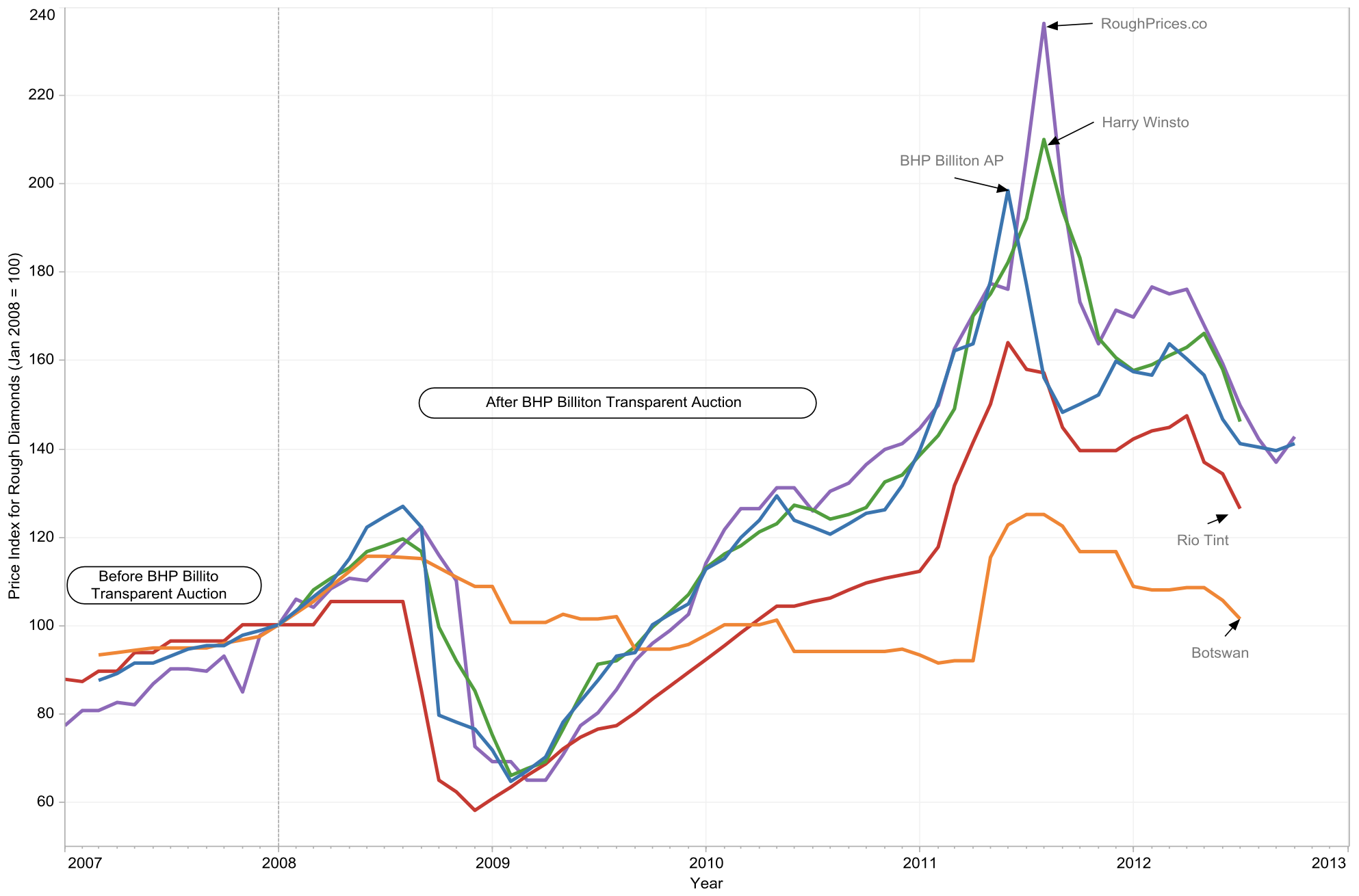Diamond Industry News: Updates Of Diamond Auctions And Tenders [March 2024]
The start of 2024 has seen many newsworthy events in rough diamond sales:
- Trans Atlantic Gem Sales (TAGS) sold $25m rough in February, an increase from $14m rough in January. [1], [2]
- De Beers brought in $430m in February, an increase from $374m in January. [3]
This indicates that rough diamond demand is still lower than usual. However, the market is in the process of returning—albeit slowly and cautiously.
In this article, you’ll discover how to adjust the sales strategy of rough diamonds based on market conditions. You’ll learn:
- When to switch to tenders - and auctions (and vice versa) for maximum revenue.
- How to know when to switch sales strategies based on covert market signals.
- How to choose technology that allows you to make that switch easily and effortlessly

Tenders Or Auctions In Volatile Market Conditions
It’s no secret that 2023 was rough for the rough diamond industry (no pun intended).
For the diamond mining giant De Beers, the last two Sights of 2023 generated only $216 million. A steep fall from the $871 million recorded the previous year. [4]
As a strategy to stimulate sales, De Beers reduced prices for its rough diamonds across the entire spectrum by at least 10%.
Furthermore, at the first sight of the year in Gaborone, Botswana, some larger diamonds were even available at discounted rates of up to 25%. [5]

And then, early this year, while stimulating sales during reduced market demand, De Beers has also modified their sale strategy and switched to sealed bids. [6] But why does it matter?

De Beers represents the diamond industry market [7] and often generates followers in the market dynamics. If De Beers reduces prices and even moves to a different sale approach like sealed bids, then smaller mining firms looking to maximize revenue might be advised to do the same.
Now, you might already have a similar sales strategy. But are you certain that it’s the right one for you? Or are you leaving potential revenue on the table?
Let’s look at history to determine the best sales strategies:
Rough Diamond Industry And The Risk Of Price Inefficiency
In the early 21st century, because of increased competition and financial crises, the go-to sales strategy that was gradually implemented in the rough diamond market was Tenders.
As a reference:
Auctions refer primarily to ‘ascending clock auctions.’ The pricing is more transparent, with price discovery happening over multiple rounds. Buyers have an opportunity to see how many bidders have bid on the same lot.
Tenders refer to ‘sealed bids’. The pricing is not transparent, and buyers rely on their own analysis to determine the best price (and have no way of knowing how many bidders are also interested in the lot). Tenders typically reflect opinioned market prices or individual interest
This created relatively volatile market dynamics, which are a breeding ground for pricing inefficiency:
 Image source: Cramton et al. (2012).
Image source: Cramton et al. (2012).
You'll notice a distinct pattern in pricing trends pre-2007, followed by a remarkable transformation upon BHP Billiton's adoption of auctions (Blue Line).
BHP Billiton’s rapid emergence as a pricing frontrunner is clear. Other indices consistently trail them by at least a month - or maintain a lower position.
As the authors of the study "Auctioning Rough Diamonds: A Competitive Sales Process for BHP Billiton’s Ekati Diamonds" wrote: [8]
“The auction approach does a better job of assigning and pricing the mine's output. Customers compete directly in simple auctions. In this way, the diamonds are allocated to the customers with the highest values, and the prices paid reflect current market conditions. [...] Prices are competitively determined, with much less reliance on the price book."
Adjusting the sales strategy helped BHP Billiton generate more revenue. Yet, during the 2008 financial crisis, BHP Billton’s price index had the strongest percentage decrease.
This suggests that tenders remain the go-to sales strategy in cautious market conditions. There are two reasons for this:
- There may not be as many bidders, and showing lower demand on the lot may lead to lower pricing (less social proof).
- Companies may not wish to be fully transparent with their pricing and disclose true price volatility, as this may undermine trust in their pricing and incentivize speculation.
This is why we often see an adjustment of companies’s sales strategy based on market conditions:
Rough Diamond Sales In The Present
The selling strategies of rough diamonds in the present are dynamic, influenced namely by:
- Overall company strategy: Certain companies have built their in-house bidding software to support only one certain type of bidding (which they claim maximizes profit).
- Market conditions: Leading companies adjust their selling strategy based on demand growth - or shrinkage.
- Stone type and size: Large and special stones are often sold differently than parcels and Run of Mine (ROM) goods.
In the previous section, we’ve seen De Beers switching to sealed bids in situations of slow markets (reduced demands), irrespective of their past company strategy.
Overall, we observe more companies running tenders (sealed bids) than auctions in questionable markets, as this may be more optimal to maximize revenue.
In auctions, buyers discover true market prices through the bids of others. When there’s less demand, there are fewer bids and the value will be lower. This may distort the perception of the potential buyer, seeing the stones as less valuable as they are.
In tenders, buyers do not discover true market prices but rely on available, often opinionated price books. When there’s less demand, there are still fewer bids, but the average bids tend to be higher. This is due to buyers relying more on personal assessment - instead of other buyers's signals.
Whether or not to use auctions and tenders should depend on the market dynamics.
So, it’s beneficial for companies to use auction and tender software that allows mining companies, tender houses, and other sellers to tweak and modify their online selling strategy almost effortlessly.
Rough Diamond Sales In The Future: Online Auctions
Next to the switch to sealed bids, it’s worth noting that De Beers also added further investment into their online platform. [9]
We expect that this is a strategic investment, making it further difficult for other companies to catch up - in an industry that is innovating at a rapid pace.
So, instead of innovating by building your own technology, we strongly suggest investing in an already existing solution.
Why? Because most companies strongly underestimate the continuous effort and cost required to maintain their custom-built solutions.
Many of our clients at BidGemmer report substantial investments into their own software, before finally moving over to a trusted, customized solution like ours.
Here are 5 of the most common challenges we commonly see in companies building their own bidding software:
- Security leaks: Many people want access to the sensitive data of the diamond industry, this includes hackers and your competitors (which software you may use).
- Ongoing (and never-ending) maintenance from developers. And developers are very expensive.
- Lack of flexibility in adjusting and testing their sales strategy: Tenders to auctions, and vice versa.
- Lacking market-leading solutions and innovation to improve internal processes and sales.
- Lacking support and guidelines for your employees and your customers.
At this stage, we’d like to invite you to learn more about the true cost of building your enterprise auction platform by downloading our free whitepaper here: https://bidgemmer.com
Conclusion:
As we look at the rough diamond industry at the beginning of 2024, it’s becoming increasingly evident that the market is rebounding - although slowly and cautiously.
As such, we recommend you to challenge your selling strategies- which may reduce pricing inefficiency in volatile markets and lead to higher revenues.
To rapidly make that change in sales strategy in an increasingly volatile environment, we welcome you to read more about BidGemmer solutions.

BidGemmer is an industry-leading software with a comprehensive ecosystem that makes online auctions and online tenders plug-and-play.
Our technology has been used to sell over $160B+ in auctions and has been in the market for 10+ years. You can learn more about our software here, or request a demo here: https://bidgemmer.com/get-started
References:
[1] Rapaport - Buyers "Positive" as TAGS Sells $14m Rough: http://www.idexonline.com/FullArticle?Id=49227
[2] TAGS Sells $25m Rough as Prices Start to Recover: https://www.idexonline.com/FullArticle?id=49324
[3] De Beers Sales Improve, but Still Down at February Sight: https://rapaport.com/news/de-beers-sales-improve-but-still-down-at-february-sight/
[4] De Beers Group - Rough Diamond Sales: https://www.debeersgroup.com/reports/rough-diamond-sales
[5] The Israeli Diamond Industry - Reports: De Beers Cuts Rough Prices by At Least 10%: https://en.israelidiamond.co.il/news/world/de-beers-cuts-rough-prices/
[6] The Free Library - De Beers introduces sealed bids in response to market dynamics: https://www.thefreelibrary.com/De+Beers+introduces+sealed+bids+in+response+to+market+dynamics.-a0781449433
[7] Edahn Golan - De Beers and ALROSA Market Share 2021: https://www.edahngolan.com/de-beers-and-alrosa-market-share-2021/
[8] Auctioning Rough Diamonds: A Competitive Sales Process for BHP Billiton’s Ekati Diamonds: https://academic.oup.com/book/26714/chapter-abstract/195544899?redirectedFrom=fulltext
[9] De Beers Unveils Online Platform for Rough Diamond Sales: https://en.israelidiamond.co.il/news/world/de-beers-online-platform/
![Diamond Industry News: Updates Of Diamond Auctions And Tenders [March 2024]](/static/blog3-85a88ad79ed79c4a9a2c25d93668e2e8.jpeg)